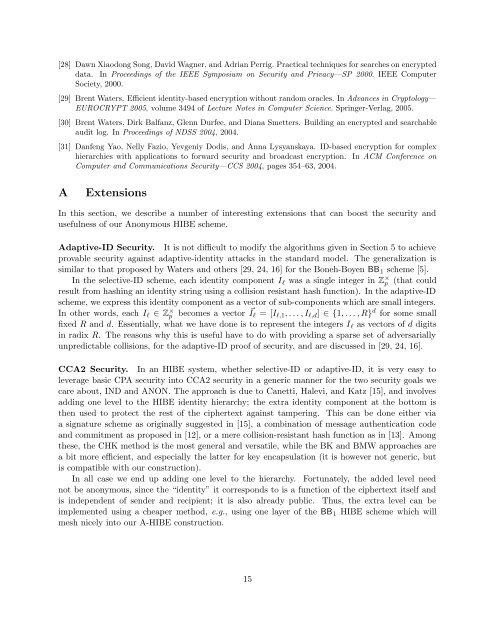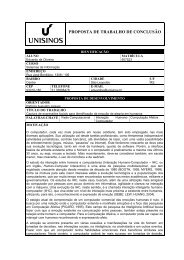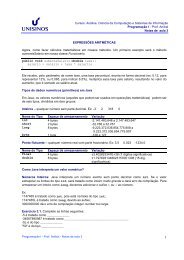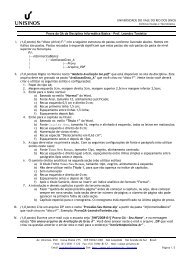[9] Dan Boneh, Xavier Boyen, and Hovav Shacham. Short group signatures. In Advances in Cryptology—CRYPTO 2004, volume 3152 of Lecture Notes in Computer Science, pages 41–55. Springer-Verlag,2004.[10] Dan Boneh, Giovanni Di Crescenzo, Rafail Ostrovsky, and Giuseppe Persiano. Public key encryptionwith keyword search. In Advances in Cryptology—EUROCRYPT 2004, volume 3027 of Lecture Notesin Computer Science, pages 506–22. Springer-Verlag, 2004.[11] Dan Boneh and Matthew Franklin. <strong>Identity</strong>-based encryption from the Weil pairing. SIAM Journal ofComputing, 32(3):586–615, 2003. Extended abstract in Advances in Cryptology—CRYPTO 2001.[12] Dan Boneh and Jonathan Katz. Improved efficiency for CCA-secure cryptosystems built using identitybased encryption. In Proceedings of CT-RSA 2005, volume 3376 of Lecture Notes in Computer Science.Springer-Verlag, 2005.[13] Xavier Boyen, Qixiang Mei, and Brent Waters. Direct chosen ciphertext security from identity-basedtechniques. In ACM Conference on Computer and Communications Security—CCS 2005. ACM Press,2005.[14] Ran Canetti, Shai Halevi, and Jonathan Katz. A forward-secure public-key encryption scheme. InAdvances in Cryptology—EUROCRYPT 2003, volume 2656 of Lecture Notes in Computer Science.Springer-Verlag, 2003.[15] Ran Canetti, Shai Halevi, and Jonathan Katz. Chosen-ciphertext security from identity-based encryption.In Advances in Cryptology—EUROCRYPT 2004, volume 3027 of Lecture Notes in ComputerScience, pages 207–22. Springer-Verlag, 2004.[16] Sanjit Chatterjee and Palash Sarkar. Trading time for space: Towards an efficient IBE scheme withshort(er) public parameters in the standard model. In Proceedings of ICISC 2005, 2005.[17] Clifford Cocks. An identity based encryption scheme based on quadratic residues. In Proceedings of the8th IMA International Conference on Cryptography and Coding, 2001.[18] Darren Davis, Fabian Monrose, and Michael K. Reiter. Time-scoped searching of encrypted audit logs.In Proceedings of ICICS 2004, pages 532–45, 2004.[19] Craig Gentry and Alice Silverberg. <strong>Hierarchical</strong> ID-based cryptography. In Proceedings of ASIACRYPT2002, Lecture Notes in Computer Science. Springer-Verlag, 2002.[20] Jeremy Horwitz and Ben Lynn. Towards hierarchical identity-based encryption. In Advances inCryptology—EUROCRYPT 2002, Lecture Notes in Computer Science, pages 466–81. Springer-Verlag,2002.[21] Antoine Joux. A one round protocol for tripartite Diffie-Hellman. Journal of Cryptology, 17(4):263–76,2004. Extended abstract in Proceedings of ANTS IV, 2000.[22] Alfred Menezes, Tatsuaki Okamoto, and Scott Vanstone. Reducing elliptic curve logarithms in a finitefield. IEEE Transactions on Information Theory, 39(5):1639–46, 1993.[23] Victor Miller. The Weil pairing, and its efficient calculation. Journal of Cryptology, 17(4), 2004.[24] David Naccache. Secure and practical identity-based encryption. Cryptology ePrint Archive, Report2005/369, 2005. http://eprint.iacr.org/.[25] Moni Naor. Invited talk at CRYPTO 2003, August 2003.[26] Adi Shamir. <strong>Identity</strong>-based cryptosystems and signature schemes. In Advances in Cryptology—CRYPTO1984, volume 196 of Lecture Notes in Computer Science, pages 47–53. Springer-Verlag, 1984.[27] Victor Shoup. Lower bounds for discrete logarithms and related problems. In Advances in Cryptology—EUROCRYPT 1997, volume 1233 of Lecture Notes in Computer Science. Springer-Verlag, 1997.14
[28] Dawn Xiaodong Song, David Wagner, and Adrian Perrig. Practical techniques for searches on encrypteddata. In Proceedings of the IEEE Symposium on Security and Privacy—SP 2000. IEEE ComputerSociety, 2000.[29] Brent Waters. Efficient identity-based encryption without random oracles. In Advances in Cryptology—EUROCRYPT 2005, volume 3494 of Lecture Notes in Computer Science. Springer-Verlag, 2005.[30] Brent Waters, Dirk Balfanz, Glenn Durfee, and Diana Smetters. Building an encrypted and searchableaudit log. In Proceedings of NDSS 2004, 2004.[31] Danfeng Yao, Nelly Fazio, Yevgeniy Dodis, and Anna Lysyanskaya. ID-based encryption for complexhierarchies with applications to forward security and broadcast encryption. In ACM Conference onComputer and Communications Security—CCS 2004, pages 354–63, 2004.AExtensionsIn this section, we describe a number of interesting extensions that can boost the security andusefulness of our <strong>Anonymous</strong> HIBE scheme.Adaptive-ID Security. It is not difficult to modify the algorithms given in Section 5 to achieveprovable security against adaptive-identity attacks in the standard model. The generalization issimilar to that proposed by Waters and others [29, 24, 16] for the Boneh-Boyen BB 1 scheme [5].In the selective-ID scheme, each identity component I l was a single integer in Z × p (that couldresult from hashing an identity string using a collision resistant hash function). In the adaptive-IDscheme, we express this identity component as a vector of sub-components which are small integers.In other words, each I l ∈ Z × p becomes a vector I ⃗ l = [I l,1 , . . . , I l,d ] ∈ {1, . . . , R} d for some smallfixed R and d. Essentially, what we have done is to represent the integers I l as vectors of d digitsin radix R. The reasons why this is useful have to do with providing a sparse set of adversariallyunpredictable collisions, for the adaptive-ID proof of security, and are discussed in [29, 24, 16].CCA2 Security. In an HIBE system, whether selective-ID or adaptive-ID, it is very easy toleverage basic CPA security into CCA2 security in a generic manner for the two security goals wecare about, IND and ANON. The approach is due to Canetti, Halevi, and Katz [15], and involvesadding one level to the HIBE identity hierarchy; the extra identity component at the bottom isthen used to protect the rest of the ciphertext against tampering. This can be done either viaa signature scheme as originally suggested in [15], a combination of message authentication codeand commitment as proposed in [12], or a mere collision-resistant hash function as in [13]. Amongthese, the CHK method is the most general and versatile, while the BK and BMW approaches area bit more efficient, and especially the latter for key encapsulation (it is however not generic, butis compatible with our construction).In all case we end up adding one level to the hierarchy. Fortunately, the added level neednot be anonymous, since the “identity” it corresponds to is a function of the ciphertext itself andis independent of sender and recipient; it is also already public. Thus, the extra level can beimplemented using a cheaper method, e.g., using one layer of the BB 1 HIBE scheme which willmesh nicely into our A-HIBE construction.15
- Page 1 and 2: This paper is available from the IA
- Page 3 and 4: invertible homomorphism, etc.). To
- Page 5 and 6: Informally, we say that an assumpti
- Page 7: 4 A Primer : Anonymous IBEWe start
- Page 10 and 11: Setup(1 Σ , D) To generate the pub
- Page 12 and 13: Encrypt(Pub, Id, Msg) To encrypt a
- Page 16 and 17: Threshold. It is a known result [8]
- Page 18 and 19: Proof of Theorem 6. We prove the th
- Page 20 and 21: On the other hand, we have, for l =
- Page 22 and 23: CT ∗ real = [E, c 0, [c 0,(a) , c
- Page 24 and 25: and the re-randomization portion as
- Page 26 and 27: then, we can equate, for every l =
- Page 28: This concludes the description of t
















